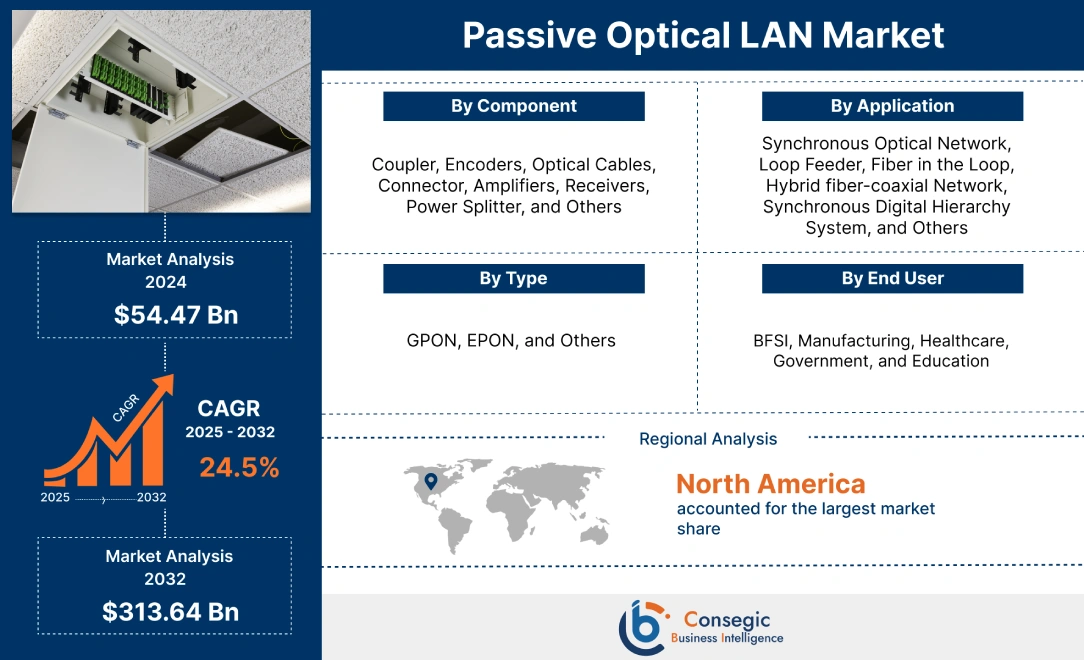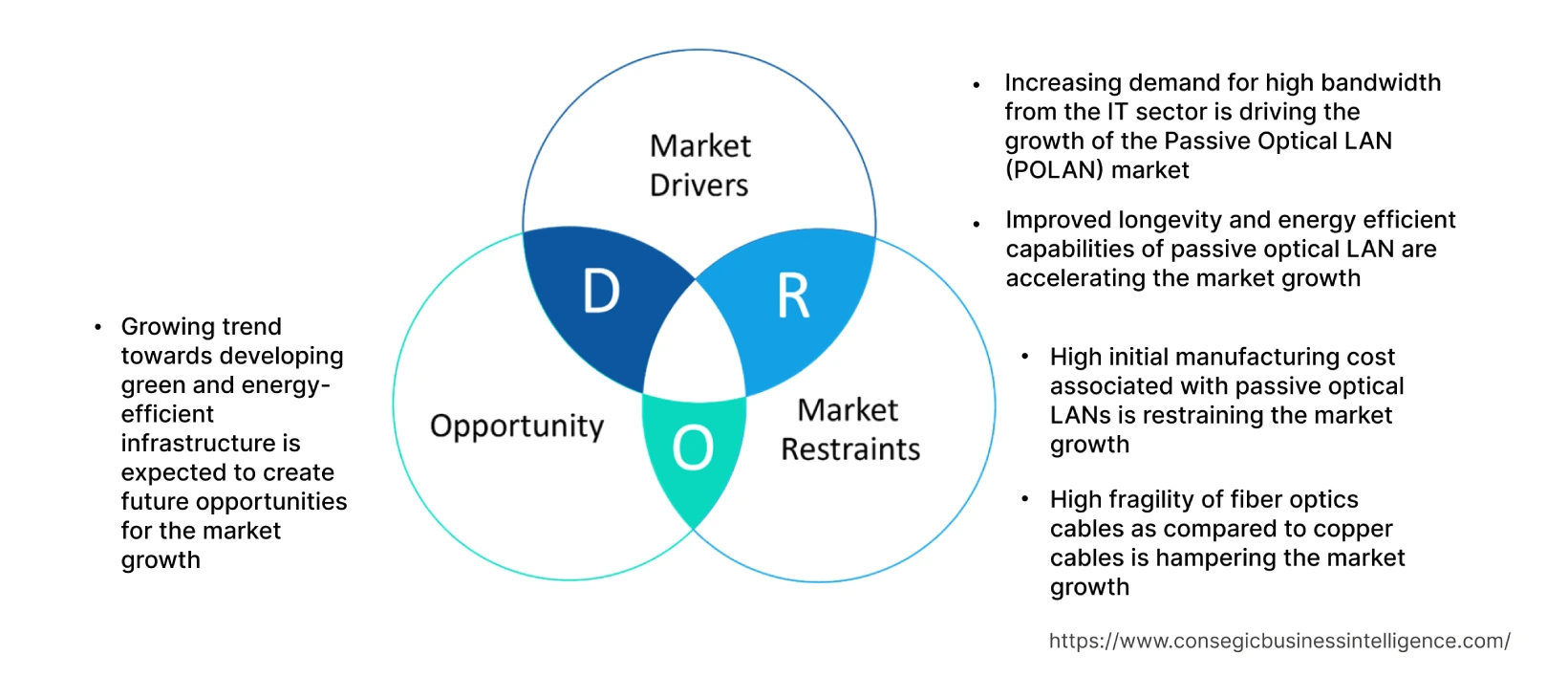Passive Optical LAN (POL) Market Introduction :
Passive Optical LAN (POL) Market is estimated to reach over USD 313.64 Billion by 2032 from a value of USD 54.47 Billion in 2024, growing at a CAGR of 24.5% from 2025 to 2032.
Passive Optical LAN (POL) Market Definition & Overview:
Passive Optical LAN (POLAN) is a fiber optic-based networking technology that eliminates the need for active electronic components including switches. Passive optical LAN delivers high-speed data, voice, and video services to end-users by using fiber optic cables to carry both data and power. Additionally, POLAN also provides increased bandwidth, longer transmission distances, scalability, reduced power consumption, and enhanced security. Furthermore, passive optical LAN serves as an efficient and cost-effective solution for high-speed data transmission in large enterprise networks and multi-dwelling units.
Passive Optical LAN (POL) Market Insights :
Passive Optical LAN (POL) Market Dynamics - (DRO) :
Key Drivers :
Increasing demand for high bandwidth from the IT sector is driving the growth of the Passive Optical LAN (POLAN) market
The IT sector encompasses a wide range of businesses, including enterprises, data centers, and cloud service providers that rely heavily on robust and high-speed networks to support the operations. Additionally, data centers serve as central repositories for storing, processing, and distributing vast amounts of data. The facilities require ultra-fast and reliable network connectivity to handle data traffic within data centers. POLAN's fiber optic infrastructure offers the necessary bandwidth capacity to support high-speed connections between servers, storage systems, and networking equipment, enabling efficient data transfers and reducing latency.
Moreover, cloud service providers deliver a range of services, including infrastructure as a service (IaaS), platform as a service (PaaS), and software as a service (SaaS). The services require high-speed and low-latency connectivity to ensure seamless access to cloud resources. POLAN's fiber optic technology provides the bandwidth and performance needed to support the rapid data transfers between users and cloud platforms. Consequently, the increasing demand of passive optical LAN from data centers and cloud service providers to provide essential bandwidth is driving the growth of the market. For instance, in November 2020, Tellabs Access LLC and Tyto Athene LLC partnered together to launch the ACUITY LAN solution, an optical LAN network to provide essential bandwidth, storage, and effective communication to data centers. The optical solution is designed to deliver essential bandwidth needed for the efficient transfer of data, thus contributing significantly in driving the market growth.
Improved longevity and energy efficient capabilities of passive optical LAN are accelerating the market growth
Fiber optic cables provide greater longevity and reliability, resulting in reduced replacement and maintenance costs over time as compared to copper wires. Additionally, passive optical LAN eliminates the need for separate power cabling, as power is transmitted over the same fiber optic cable, reducing the overall infrastructure cost. Moreover, POLAN is designed to be energy efficient as power is centralized at the Optical Line Terminal (OLT) and distributed to endpoints including Optical Network Terminals (ONTs). Efficient power distribution eliminates the need for network switches and reduces energy consumption, thus contributing notably in fueling the market growth. Consequently, by leveraging the passive nature of POLAN, organizations achieve significant energy savings and eliminate the need for active electronic components in the distribution network. For instance, in July 2022, Nokia and Orange France deployed passive optical LAN solutions over 20 sites in France. The advanced optical LAN networks are deployed to offer low-energy solutions and longevity to the user for campus and in-building connectivity, thus contributing remarkably in propelling the market growth.
Key Restraints :
High initial manufacturing cost associated with passive optical LANs is restraining the market growth
The cost of production of passive optical LANs is expensive and limits the adoption of POLAN, especially among small and medium-sized enterprises (SMEs) with limited resources. The expensive components installed in passive optical LANs namely fiber optic cables, optical splitters, OLTs, and ONTs lead to additional upfront costs. Additionally, the expenses related to network planning, design, engineering, and project management also contribute to additional upfront costs, further limiting the adoption of passive optical LANs. The additional upfront cost compels the user to seek traditional copper cables, thus limiting the adoption of POLANs and impeding the growth of the global passive optical LAN market.
High fragility of fiber optics cables as compared to copper cables is hampering the market growth
Fiber optic cables require careful handling and installation to prevent damage as the cables are sensitive to bending, twisting, excessive tension, and environmental factors including moisture, temperature, and chemicals. The installation and handling process of fiber optics requires specialized knowledge and skills that further increase the labor cost. Additionally, fiber optics cables are susceptible to damage from factors including accidental cuts, construction work, and equipment failures. The fragility of fiber optics results in longer downtime during repairs and higher maintenance costs, negatively impacting the operational efficiency and reliability of the network. Consequently, the highly fragile nature of fiber optics cables is the major factor responsible for hampering the growth of the global passive optical LAN market.
Future Opportunities :
Growing trend towards developing green and energy-efficient infrastructure is expected to create future opportunities for the market growth
Passive optical LAN is energy-efficient and reduces power consumption and heat generation in comparison to copper cables. Cables made from copper have harmful environmental impacts whereas optical fiber cabling has 60% less plastic jacketing and is more environmentally friendly. Additionally, passive optical LAN also lowers power consumption by approximately 30-50%, thus helping organizations to decrease greenhouse gas emissions and environmental impact. For instance, the Department of Energy Sandia National Laboratory saved approximately 65% in power consumption by utilizing Tellab's optical LAN network. Consequently, the ability of passive optical LAN networks to offer energy-efficient and environmentally friendly infrastructure is expected to create opportunities for market growth.
Passive Optical LAN (POL) Market Report Insights :
| Report Attributes | Report Details |
| Study Timeline | 2019-2032 |
| Market Size in 2032 | USD 313.64 Billion |
| CAGR (2025-2032) | 24.5% |
| By Component | Coupler, Encoders, Optical Cables, Connector, Amplifiers, Receivers, Power Splitter, and Others |
| By Type | GPON, EPON, and Others |
| By Application | Synchronous Optical Network, Loop Feeder, Fiber in the Loop, Hybrid fiber-coaxial Network, Synchronous Digital Hierarchy System, and Others |
| By End-User | BFSI, Manufacturing, Healthcare, Government, and Education |
| By Region | North America, Europe, Asia-Pacific, Latin America, and Middle East & Africa |
| Key Players | ZTE Corporation, TP-Link Corporation Limited., Telefonaktiebolaget LM Ericsson, Nokia Corporation, Infinera Corporation, Huawei Investment & Holding Co., Ltd., CISCO SYSTEMS, INC., Ciena Corporation, Calix Inc., ADTRAN Inc. |
Passive Optical LAN (POL) Market Segmental Analysis :
Based on the Component :
The component segment is categorized into coupler, encoders, optical cables, connector, amplifiers, receivers, power splitter, and others. Optical cables accounted for the largest market share in 2024 owing to the higher bandwidth capacity compared to traditional copper cables. Optical cables transmit large volumes of data over long distances without experiencing signal loss, thus contributing in promoting the growth of the segment. Additionally, optical cables are not susceptible to electromagnetic interference (EMI) and radio frequency interference (RFI) as copper cables. Optical cables do not emit electromagnetic signals and are immune to external electromagnetic fields, ensuring reliable data transmission and reducing the risk of signal loss. Moreover, cables aid in reducing the carbon footprint and are increasingly adopted in warehouse-scale computing for powering connectivity. For instance, in October 2022, Sterlite Technologies Limited launched multi-core fiber and cable to improve the optical connectivity landscape of India. The advanced optical fiber helps in lowering the carbon footprint by reducing the cable surface area and plastic by 75% and 10% respectively. The optical fibers also support efficient quantum communication, thus contributing significantly in driving the growth of optical fibers segment.
Power splitters are predicted to witness the fastest CAGR in the passive optical LAN during the forecast period. Power splitters are essential components in POLAN networks to enable the distribution of optical signals to multiple endpoints and receivers. In addition, power splitters provide the scalability and flexibility to accommodate the growing number of endpoints, hence becoming a crucial component in POLAN deployments. Moreover, the increasing adoption of Fiber to the Home (FTTH) networks to provide improved bandwidth is also contributing in driving the growth of power splitters segment. Power splitters are essential in FTTH deployments to enable the sharing of optical signals among multiple homes and units. Consequently, the increasing demand for high-speed internet access and advanced services in residential areas is expected to drive the growth of power splitters in the POLAN market.
Based on the Type :
The type segment is trifurcated into GPON, EPON, and others. Gigabit Passive Optical Network (GPON) type accounted for the largest market share in 2024 as GPON provides a high-speed data transmission capability, offering downstream bandwidths of up to 2.5 Gbps and upstream bandwidths of up to 1.25 Gbps. The high bandwidth capacity is suitable for handling the increasing data demands of modern networks, including video streaming, cloud computing, and IoT applications. In addition, GPON also offers higher bandwidth and high upload speeds, superior gaming performance, further driving the growth of the gigabit passive optical network segment. For instance, in March 2023, Vianet Communication Ltd. launched 2Gbps XGS-PON with 10 gigabit symmetrical passive optical network and a maximum upload speed of 1.2 Gbps and download speed of 2.4 Gbps. Advanced technology enables seamless streaming, superior gaming performance, and faster download and upload speeds, thus contributing notably in bolstering the market growth.
Ethernet passive optical network (EPON) is anticipated to witness the fastest CAGR during the forecast period. The growth of the market is endorsed by the ability of EPON to offer symmetrical bandwidth, providing equal upstream and downstream speeds. The symmetrical nature is particularly advantageous for applications that require symmetric data transfer namely video conferencing, cloud services, and real-time data sharing. In addition, EPON's integration with Ethernet protocols enables seamless delivery of Ethernet-based services over the optical network. The integration allows service providers to offer a wide range of Ethernet services, including internet access, voice over IP (VoIP), and enterprise connectivity, leveraging the existing Ethernet infrastructure. In conclusion, the aforementioned factors, including the increasing demand for bi-directional high-speed connectivity are contributing in driving the growth of EPON segment during the forecast period.
Based on the Application :
The application segment is classified into synchronous optical network, loop feeder, fiber in the loop, hybrid fiber-coaxial network, synchronous digital hierarchy system, and others. Hybrid fiber coaxial (HFC) networks accounted for the largest market share in 2024 as HFC networks experience limited bandwidth capacity with the increasing number of connected subscribers. Passive optical LAN enables network operators to perform node splitting, which involves dividing the service area into smaller clusters. Fiber optic cables are extended to the smaller clusters, increasing available bandwidth and reducing signal loss over longer coaxial cable lengths. In addition, passive optical LANs provide efficient and reliable backhaul connectivity for HFC networks by using fiber optic cables to provide higher capacity and faster transmission speeds. Moreover, the presence of key players in the region, constantly applying innovations and strategic decisions to expand the market portfolio is also contributing significantly in driving the growth of the hybrid fiber-coaxial cable segment. For instance, in January 2023, Orange Belgium and Telenet signed a contract to extend the commercial wholesale agreement for 15 years, enabling the users to access hybrid fiber-coaxial networks and fiber to the home. The aim of the agreement is to offer convenience to the users and also to expand the portfolio in the Belgian telecommunication market.
Synchronous Optical Network (SONET) is predicted to register the fastest CAGR in the passive optical LAN market during the forecast period. SONET is primarily utilized for long-haul transport and backbone connectivity and passive optical LAN is used for distributing high-bandwidth connections to endpoints within the enterprise including office spaces, data centers, and research facilities. Additionally, SONET networks rely on fiber optic cables for long-haul transmission and passive optical LAN is employed to distribute the optical fiber connectivity within localized areas including multi-story buildings and campuses. The distribution enables efficient and reliable fiber-based connectivity to individual endpoints, thus contributing significantly in promoting the growth of synchronous optical network segment.
Based on the End-User :
The end-user segment is divided into BFSI, manufacturing, healthcare, government, and education. BFSI accounted for the largest market share of 27.4% in 2024 as the sector deals with sensitive and confidential data, including financial transactions, customer information, and trade secrets. Passive optical LAN offers enhanced security features including fiber encryption, physical layer security, and centralized control to prevent the leakage of customer data. In addition, the BFSI sector generates and processes large volumes of data, requiring high-speed and reliable network connectivity. POLAN's fiber optic infrastructure provides higher bandwidth, enabling seamless data transmission and supporting bandwidth-intensive applications including real-time trading, analytics, and financial transactions. For instance, in June 2023, Huawei launched F5G Intelligent OptiX Network solution to upgrade finance communication networks in the financial industry. The optical solution safeguards high transaction reliability by using advanced technologies including storage optical connection coordination and co-cable detection to eliminate the risks in data transmission, thus contributing notably in promoting the market growth.
Government sector is predicted to register the fastest CAGR in the passive optical LAN market during the forecast period. Governments worldwide are investing in digital transformation initiatives to modernize infrastructure and services including smart city initiatives and improved connectivity for government agencies. Passive optical LAN owing to the ability to deliver high-speed and reliable connectivity plays a crucial role in enabling the digital transformation efforts. Additionally, governments generate and handle a vast amount of digital data, ranging from citizen records and financial information to public safety data and administrative records. The increasing number of digital records raises the need for higher bandwidth for efficient data transfer. POLAN's high-speed capabilities and scalability serve as an attractive solution for managing the increasing data traffic within government networks, thus contributing in bolstering the growth of the government sector.
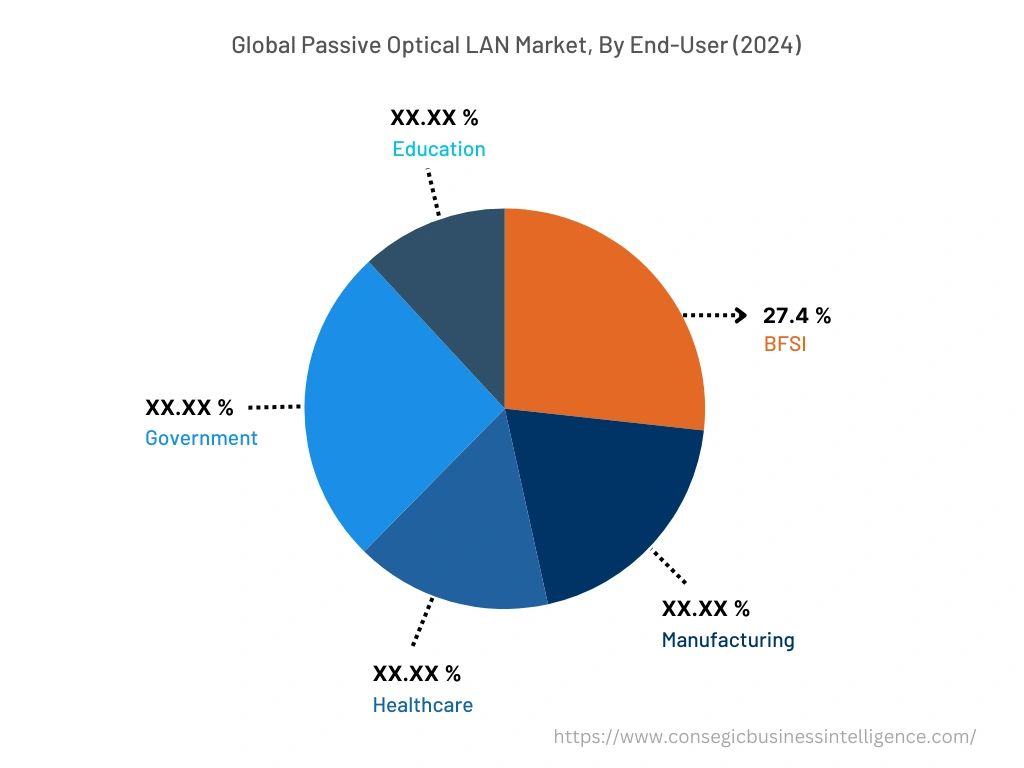
Based on the Region :
The regional segment includes North America, Europe, Asia Pacific, Middle East and Africa, and Latin America.
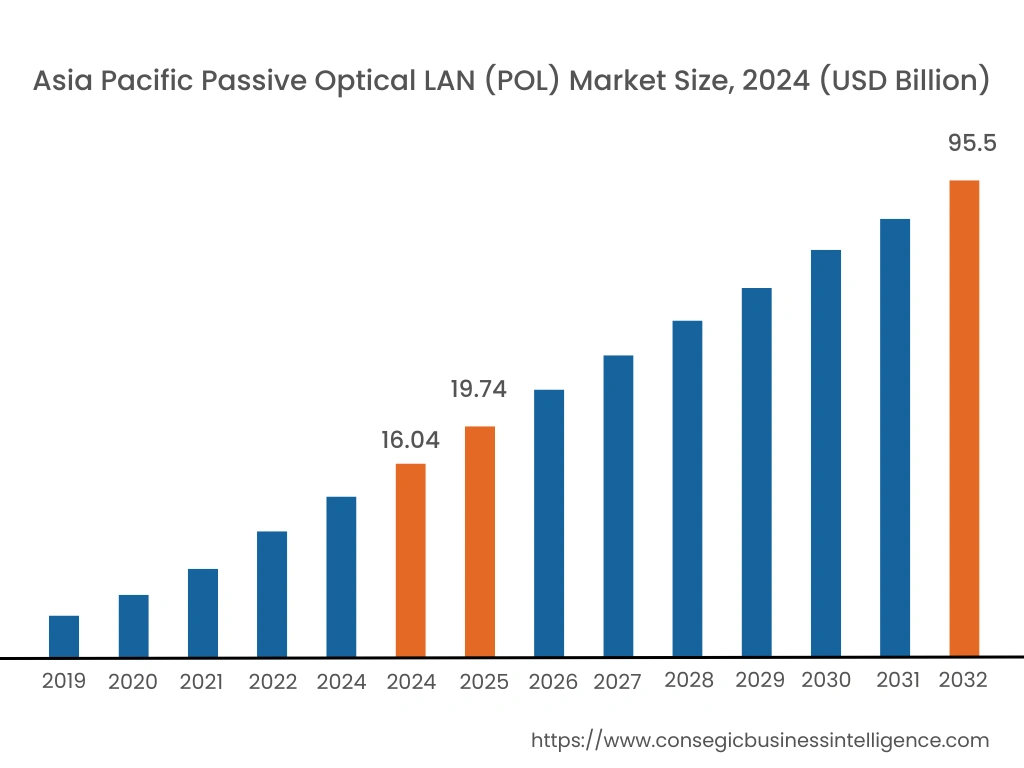
North America accounted for the largest market share in 2024 owing to the well-established IT industry and a high level of digitalization across various sectors. The growing digitalization creates a favorable environment for the adoption of passive optical LAN solutions to offer higher bandwidth, scalability, and security compared to traditional copper-based LANs. In addition, North America encompasses numerous large enterprises across various sectors including finance, healthcare, manufacturing, and government. The organizations have high bandwidth requirements, stringent security needs, and a focus on enhancing operational efficiency. Passive optical LAN is ideal for fulfilling the requirements by offering faster data transmission, improved network performance, and robust security features. Moreover, the presence of key players in the region that constantly apply strategic decisions through mergers and acquisitions is also contributing to the market growth. For instance, in August 2020, Vecima Networks completed the acquisition of EPON or DPoE Portfolio and DOCSIS distributed access architecture from Nokia. However, the companies will maintain the business relationship to offer advanced technologies to users for effective communication, thus contributing notably in bolstering the market growth in the region.
Asia Pacific accounted to USD 16.04 Billion in 2024 and is anticipated to witness the fastest CAGR of 25.00% accounting to USD 95.5 Billion in 2032 in the passive optical LAN market. In addition, in the region, China accounted for the maximum revenue share of 34.50% in the year 2024. The growth is attributed to the increasing proliferation of smartphones and internet, and also increasing digitalization that raises the demand for high-speed, reliable, and secure networking solutions. Passive optical LAN provides the necessary bandwidth, scalability, and security features to handle the increasing data traffic and support advanced services including cloud computing, video streaming, and Internet of Things (IoT) applications. Additionally, governments in the Asia Pacific region are investing heavily in smart city projects and digital transformation initiatives. The initiatives focus on improving infrastructure, transportation systems, public services, and connectivity within cities. POLAN offers advantages namely high bandwidth, efficient network management, and improved security for supporting smart city projects and government initiatives. In conclusion, the aforementioned factors are collectively responsible in accelerating the market growth in Asia Pacific countries.
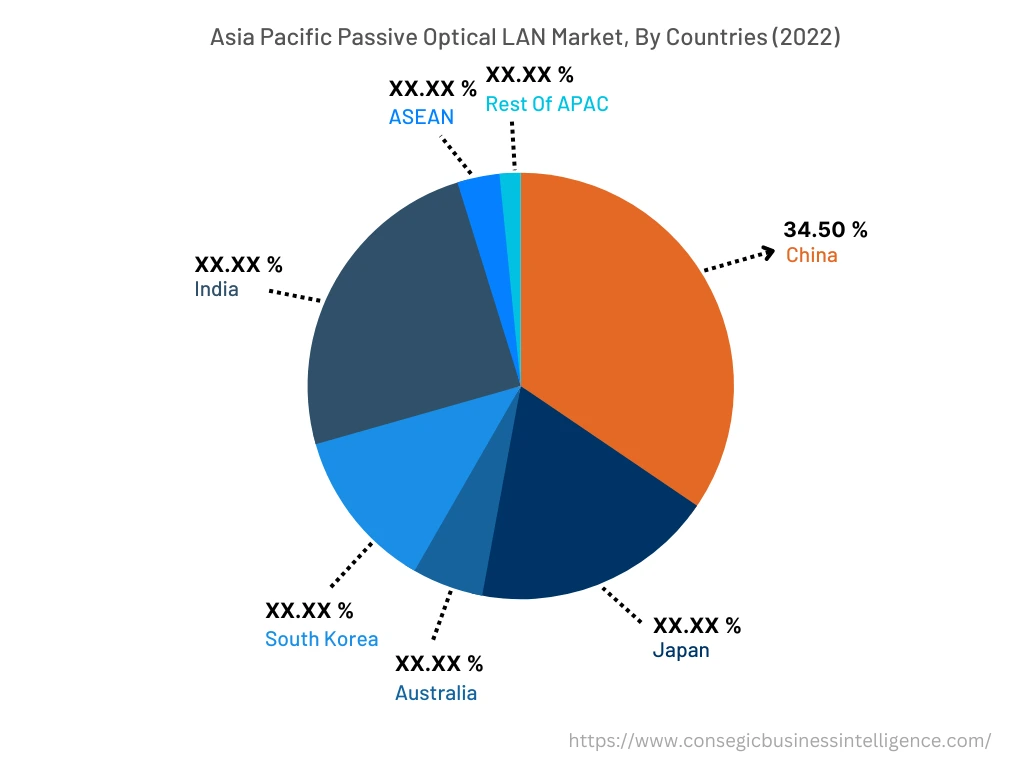
Top Key Players & Market Share Insights:
The landscape of the passive optical LAN market is highly competitive and has been examined in the report, along with complete profiles of the key players operating in the industry. In addition, the surge in innovations, acquisitions, mergers, and partnerships has further accelerated the growth of the transit card market. Major players in the market include-
- ZTE Corporation
- TP-Link Corporation Limited.
- Ciena Corporation
- Calix Inc.
- ADTRAN Inc.
- Nokia Corporation
- Telefonaktiebolaget LM Ericsson
- Infinera Corporation
- Huawei Investment & Holding Co., Ltd.
- CISCO SYSTEMS, INC.
Recent Industry Developments :
- In September 2021, ETSI launched ETSI GS F5G 003 which includes a passive optical network and passive optical LAN to provide higher better coordination, data rate, and controlled latency to devices namely HD surveillance cameras, VR/AR helmets, and HDTV.
- In May 2021, Nokia announced that its Gigabit Passive Optical Networking (GPON) solution will be utilized by AirFiber Networks to provide broadband services of high-speed in underdeveloped areas of Tamil Nadu and also in Bangalore, with an aim to reach more than 100,000 subscribers in a year.
Key Questions Answered in the Report
What is passive optical LAN? +
Passive Optical LAN (POLAN) is a fiber optic-based networking technology that eliminates the need for active electronic components including switches. Passive optical LAN delivers high-speed data, voice, and video services to end-users by using fiber optic cables to carry both data and power.
What specific segmentation details are covered in the passive optical LAN market report, and how is the dominating segment impacting the market growth? +
Gigabit Passive Optical Network (GPON) technology dominate the market in 2024 as GPON provides a high-speed data transmission capability, offering downstream bandwidths of up to 2.5 Gbps and upstream bandwidths of up to 1.25 Gbps.
What specific segmentation details are covered in the passive optical LAN market report, and how is the fastest segment anticipated to impact the market growth? +
Government sector is anticipated to register the fastest CAGR owing to the ability of passive optical LAN to offer high-speed capabilities in managing the increasing data traffic within government networks.
Which region is anticipated to witness the highest CAGR during the forecast period, 2025-2032? +
Asia Pacific is anticipated to witness the fastest CAGR during the forecast period owing to the increasing proliferation of smartphones and internet, and also increasing digitalization that raises the demand for passive optical LAN to offer high-speed, reliable, and secure networking solutions.
